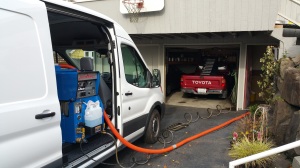What went into the decision to develop and apply the technology that powers the CDS XDrive Truckmount?
As we previously discussed, none of the new unibody construction vans can work with the present drive shaft technology of the HydraMaster CDS Truckmount, nor any of the designs of our competitors. Thus a new power transfer process had to be developed to have a van powered truckmount in the new unibody vans.
present drive shaft technology of the HydraMaster CDS Truckmount, nor any of the designs of our competitors. Thus a new power transfer process had to be developed to have a van powered truckmount in the new unibody vans.
The future of power take off and/or direct drive units installed in some of the new vehicle designs could have potentially taken on a number of forms: tailshaft power take offs; transmission power take offs,; water and oil hydraulics, pneumatic power: direct driving the blower from the engine within the engine compartment; and alternative fuels are all ideas that we evaluated.
As many long time cleaners can testify to, the use of Hydraulic power transfer in our industry does not have a very successful track record. Though the technology associated with hydraulic power has improved, one thing that kept pushing us away from hydraulics is the fact when you have hydraulic power, you have hydraulic oil leaks. Just look at the tarmac the next time you are on an airplane. Carpet cleaners who spend hours cleaning up the carpet and hard surface floors inside their customer’s home or business would not look too positively on a truckmount that dripped hydraulic oil on their customer’s driveway or parking lot. .
We even considered the fact that California may eventually require high powered squirrels running on hamster wheels to power green reduced-emission truckmounts.
In the end, our research kept taking us to one place – the hybrid and pure use of electronic power generation at kilowatt levels that were now achievable to power a truckmount. Our next update (#3) will explain how the power delivery system does work on this amazing new truckmount.

Tags: CDS, hydraulic, power, truckmount, xDrive





